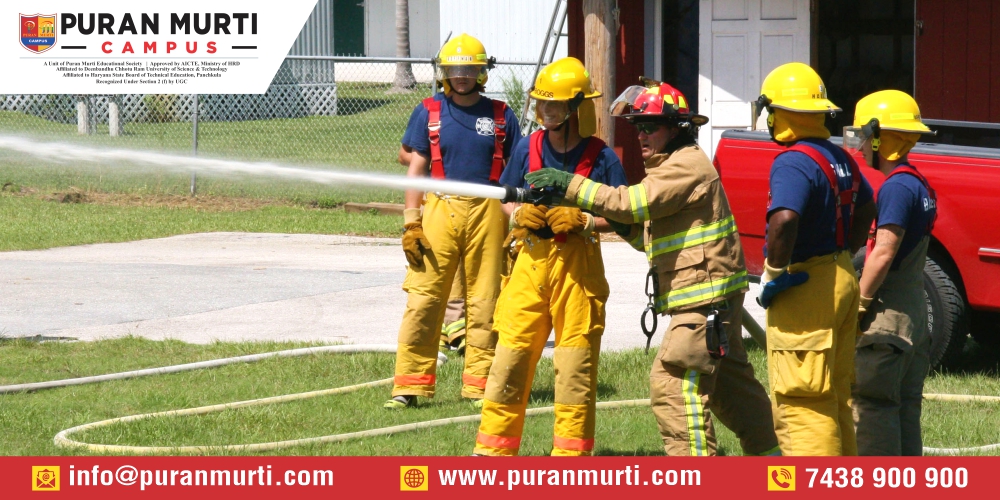Safeguarding Lives: Exploring the Diploma in Fire Technology and Safety
Posted on : 26 June, 2024 5:01 pm
Introduction
- Fire technology and safety are critical fields dedicated to safeguarding lives and property from fire hazards. A Diploma in Fire Technology and Safety equips students with the knowledge and skills needed to effectively prevent, manage, and respond to fire emergencies. This program combines theoretical learning with hands-on training, ensuring graduates are well-prepared for real-world challenges. As the demand for fire safety professionals grows, this diploma opens up various career opportunities in firefighting, industrial safety, consultancy, and more, making it an essential qualification for those passionate about protecting communities.
Understanding the Diploma in Fire Technology and Safety
- The Diploma in Fire Technology and Safety provides comprehensive training in fire prevention, risk assessment, and emergency response. Students learn about fire behavior, safety regulations, and the latest firefighting techniques. The curriculum includes both theoretical knowledge and practical skills, preparing graduates for careers in firefighting, industrial safety, and fire consultancy, ensuring they can effectively protect lives and property.
Key Subjects in Fire Technology and Safety
- Key subjects in Fire Technology and Safety include fire dynamics, fire prevention, risk assessment, and emergency response. Students also study fire safety regulations, hazardous materials management, and firefighting techniques. Practical training in fire drills, rescue operations, and the use of firefighting equipment is emphasized, ensuring students are well-prepared for real-world fire safety challenges.
Real-World Skills Development
- Real-world skills development in fire technology and safety includes hands-on training in firefighting, rescue operations, and emergency response. Students gain practical experience with firefighting equipment, conduct fire drills, and learn to manage hazardous materials. These skills are crucial for effectively preventing, assessing, and responding to fire-related incidents in various real-world scenarios.
Fire Prevention Techniques
- Fire prevention techniques involve identifying potential fire hazards, implementing safety protocols, and ensuring compliance with fire codes and standards. Key strategies include regular maintenance of electrical systems, safe storage of flammable materials, installation of fire alarms and sprinklers, and conducting fire safety training and drills. These measures help minimize the risk of fire incidents and enhance overall safety.
Safety Regulations and Compliance
- Safety regulations and compliance in fire technology ensure adherence to established safety standards and protocols. This includes following national and international fire codes, conducting regular safety audits, and implementing corrective measures. Compliance ensures that buildings and facilities are equipped with necessary safety features, such as fire alarms, extinguishers, and evacuation plans, thereby minimizing risks and enhancing overall safety.
Career Opportunities in Fire Technology and Safety
- Career opportunities in fire technology and safety are diverse and include roles such as fire safety officer, fire inspector, and emergency response coordinator. Graduates can work in industries like manufacturing, construction, and public safety, ensuring compliance with fire safety regulations, conducting risk assessments, and implementing fire prevention measures to protect lives and property.
Advanced Firefighting Technologies
- Advanced firefighting technologies include innovations such as thermal imaging cameras, drones for aerial surveillance, and automated fire suppression systems. These technologies enhance firefighting capabilities by improving situational awareness, increasing safety for firefighters, and enabling more efficient and effective responses to fire emergencies. As technology advances, these tools are becoming essential in modern fire safety strategies.
Reducing Risks
- Reducing risks in fire technology involves comprehensive training, adherence to safety protocols, and the use of advanced equipment. Implementing regular fire drills, conducting risk assessments, and maintaining updated safety standards are crucial. Additionally, leveraging technology like smoke detectors, fire alarms, and automated sprinkler systems significantly minimizes the potential for fire-related incidents and enhances overall safety.
Conclusion
- In conclusion, the field of fire technology and safety plays a pivotal role in safeguarding lives and property against the devastating effects of fire. Through rigorous training, adherence to stringent safety regulations, and the integration of advanced technologies, professionals in this field contribute significantly to mitigating risks and enhancing overall safety measures. As advancements continue to evolve, the emphasis on proactive fire prevention strategies and swift emergency response remains paramount. By fostering a culture of preparedness and continuous improvement, we can strive towards safer environments and resilient communities in the face of fire hazards.

